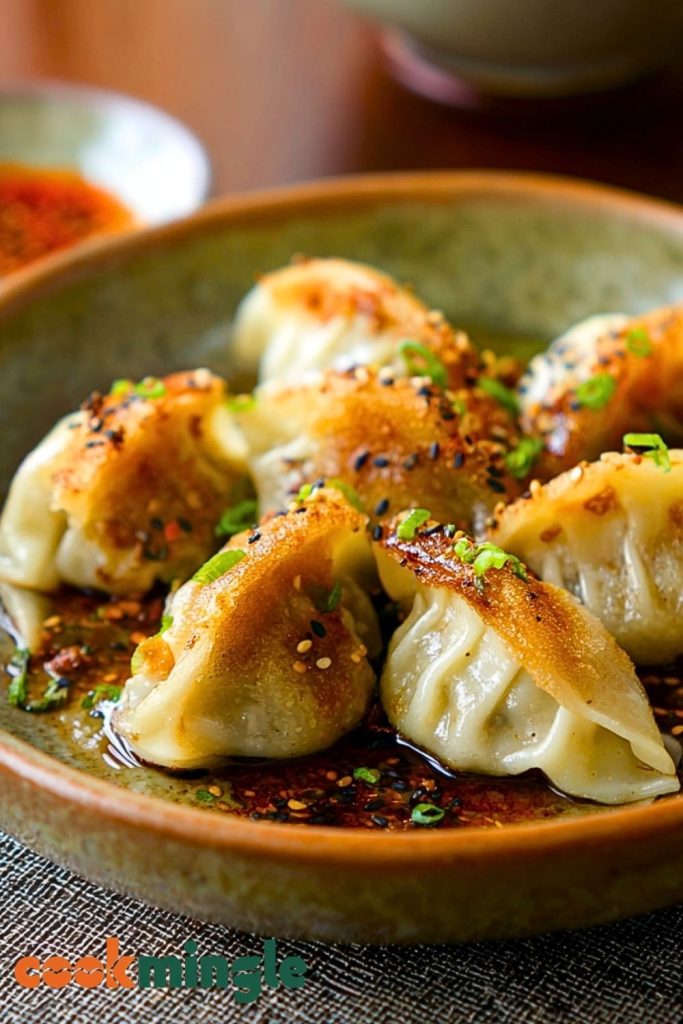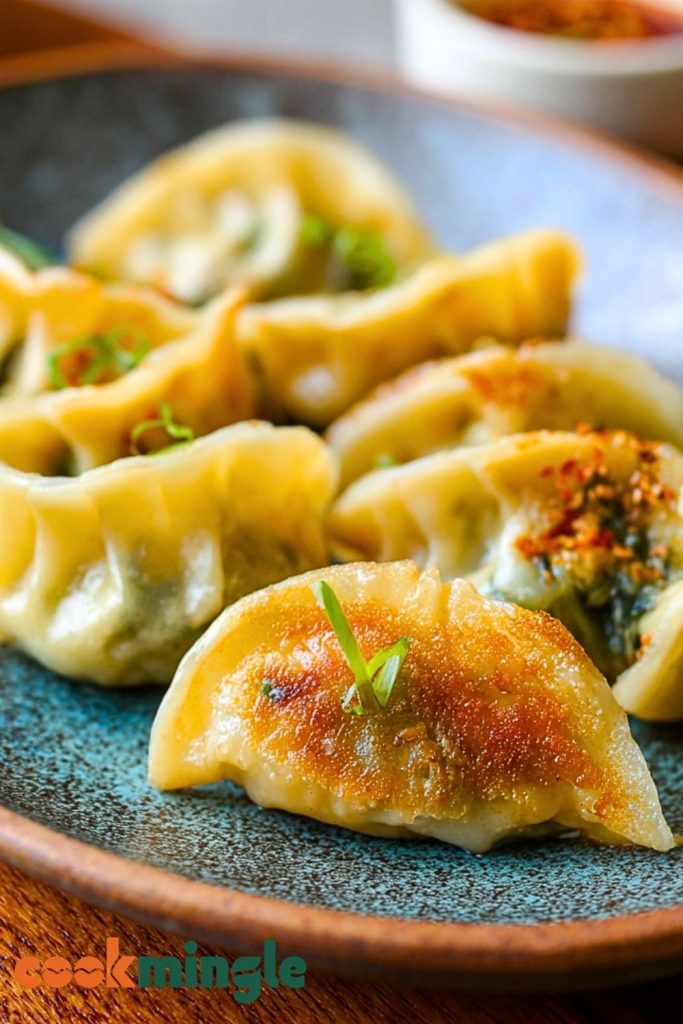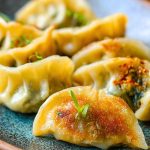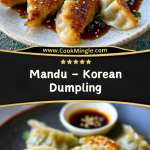Golden-crisp on the outside and juicy within, Mandu are Korean dumplings that deliver comfort in every bite. Whether pan-fried to crispy perfection or gently steamed, each dumpling wraps around a savory filling of seasoned meat and vegetables that bursts with flavor. Mandu have a storied place in Korean cuisine, often served during holidays like Lunar New Year or simply enjoyed as a street snack or cozy meal.

But their charm lies not only in tradition — Mandu are endlessly versatile and surprisingly easy to make at home. With a bit of preparation and some folding finesse, these plump dumplings can turn into a kitchen favorite, especially when paired with a spicy dipping sauce or dropped into a steaming bowl of broth.
Why You’ll Love This Mandu Recipe
- Crispy, juicy, and packed with flavor – a perfect balance of textures and tastes in every bite.
- Customizable fillings – swap the pork for tofu or mushrooms for a vegetarian twist.
- Make-ahead friendly – freeze them for quick meals whenever cravings strike.
- Fun to make – great for group cooking or family kitchen projects.
- Authentic but simple – all the traditional flavor without the complicated prep.
Preparation Phase & Tools to Use (Essential Tools and Equipment, and the Importance of Each Tool)
Before diving into folding and frying, organizing your workspace and tools can make the Mandu process much smoother and more enjoyable.
- Mixing Bowl: A large bowl is essential for combining the filling. It gives enough space to properly mix the pork, vegetables, and seasonings without spillage.
- Cutting Board & Sharp Knife: Prepping the ingredients finely is key for a well-textured filling. A sharp knife helps you chop ingredients like kimchi and garlic with precision.
- Small Spoon or Scoop: This helps in portioning the filling evenly into each wrapper, ensuring consistent cooking.
- Small Bowl of Water: Used to seal the dumplings. Dabbing water around the edges of the wrapper allows the dough to stick together when folded.
- Non-stick Skillet with Lid: For pan-frying Mandu to get that crispy bottom and steamed top. The lid helps trap steam and cook the dumplings through evenly.
- Steamer Basket (Optional): If you prefer steamed Mandu, a bamboo or metal steamer over boiling water does the trick.
- Tray & Parchment Paper: To hold folded Mandu before cooking or freezing. Parchment prevents sticking and makes clean-up easy.
Preparation Tips
- Keep wrappers covered: Dumpling wrappers can dry out quickly. Cover them with a damp towel as you work.
- Don’t overfill: It’s tempting to stuff them, but too much filling makes sealing tricky and leads to burst dumplings.
- Finely mince ingredients: Uniform pieces help the filling cook evenly and hold together better.
- Mix by hand: This gives you more control and prevents over-mixing, which can toughen the filling.
- Seal tightly: Press firmly and ensure there are no air pockets inside, which can cause them to split when cooking.
- Use a folding technique you’re comfortable with: Whether simple half-moons or fancy pleats, consistency is key.
- Fry in batches: Avoid crowding the pan so each dumpling crisps up nicely.
- Freeze uncooked Mandu in a single layer first: Then transfer to a bag or container to avoid sticking together.
Ingredients for This Mandu Recipe
Here’s everything you need to create authentic Korean Mandu at home. The filling is adaptable, so feel free to customize it based on dietary preferences.
For the Filling:
- 1 cup finely chopped kimchi (well-drained)
- ½ pound ground pork (or ground beef, chicken, or tofu)
- 1 cup firm tofu, crumbled and squeezed to remove moisture
- ½ cup green onions, finely chopped
- ½ cup bean sprouts, chopped and lightly blanched
- 2 cloves garlic, minced
- 1 teaspoon ginger, grated
- 1 tablespoon soy sauce
- 1 teaspoon sesame oil
- ½ teaspoon salt
- ¼ teaspoon black pepper
For Wrapping:
- 1 package dumpling wrappers (round or square, store-bought or homemade)
- Small bowl of water (for sealing the edges)
For Cooking:
- 2 tablespoons vegetable oil (for frying)
- ¼ cup water (for steaming in the pan)
Optional Dipping Sauce:
- 2 tablespoons soy sauce
- 1 tablespoon rice vinegar
- ½ teaspoon sesame oil
- Pinch of red pepper flakes
- Chopped green onion or a few sesame seeds (for garnish)

Step 1: Prepare the Filling
In a large bowl, combine chopped kimchi, ground pork, crumbled tofu, green onions, bean sprouts, garlic, and ginger. Mix thoroughly with your hands or a spoon until everything is well incorporated. Add soy sauce, sesame oil, salt, and pepper, then mix again until the mixture becomes cohesive and slightly sticky.
Step 2: Set Up Your Wrapping Station
Lay out your dumpling wrappers and keep them covered with a damp towel to prevent drying. Set a small bowl of water nearby for sealing, and line a tray with parchment paper to hold the finished dumplings.
Step 3: Fill and Fold the Mandu
Place one dumpling wrapper in your palm. Add about 1 to 1.5 teaspoons of filling to the center. Dip your finger in water and run it along the edge of the wrapper. Fold in half to form a half-moon or pleat along the edge for a traditional look, pressing tightly to seal.
Step 4: Cook the Mandu (Pan-Fry Method)
Heat 1 tablespoon of vegetable oil in a non-stick skillet over medium heat. Place the Mandu in the pan, flat side down, without crowding. Fry for 2–3 minutes until the bottoms are golden brown. Add about 2–3 tablespoons of water, quickly cover with a lid, and steam for 4–5 minutes until the water evaporates and the filling is cooked through. Remove lid and let crisp up again for 1 more minute.
Step 5: Optional – Steam or Boil Instead
To steam: Arrange dumplings in a steamer lined with parchment. Steam over boiling water for 8–10 minutes.
To boil: Drop into boiling water and cook for 4–6 minutes until they float and the wrappers turn translucent.
Step 6: Make the Dipping Sauce
Combine soy sauce, rice vinegar, sesame oil, and red pepper flakes in a small bowl. Add green onions and sesame seeds on top. Serve on the side.
Notes
- Kimchi choice matters: Older, well-fermented kimchi adds deeper flavor. Squeeze out excess liquid before using.
- Meat alternatives: Ground chicken, beef, or even a tofu-mushroom mix works beautifully.
- Batch-friendly: Make a large batch and freeze extras for an easy future meal. They cook straight from frozen!
- Vegan version: Skip the meat and double up on tofu, mushrooms, or mung bean sprouts for a plant-based filling.
- Dipping sauce upgrade: Add a splash of honey or grated garlic for a sweet and spicy twist.
Watch Out for These Mistakes While Cooking
- Overstuffing: Leads to burst dumplings while cooking. Stick to 1–1.5 teaspoons of filling per wrapper.
- Dry edges: Wrappers that sit out too long dry quickly and won’t seal well. Keep them covered.
- Skipping the press: Not sealing the edges firmly can cause filling to leak out during cooking.
- Too much oil or water: Overfrying or oversteaming can make the bottoms soggy or overly oily.
- Crowding the pan: This traps steam, making it hard to crisp the bottoms. Give them room.
- Using cold filling: While it’s okay to chill for food safety, overly cold filling can make the dumplings harder to seal properly.
- Uneven cooking: If using multiple cooking methods (steam + fry), time and temperature management is key.
- Wrong heat level: Medium heat is the sweet spot. Too high and the bottoms burn; too low and they won’t crisp.
What to Serve With Mandu?
Korean Mandu are incredibly versatile — they can shine as an appetizer, side dish, or main course. Complement them with these flavorful pairings for a complete and satisfying meal.
8 Recommendations:
1. Kimchi
A classic partner! Its tangy, spicy crunch balances the richness of the dumplings beautifully.
2. Japchae (Glass Noodles Stir-Fry)
Sweet potato noodles stir-fried with veggies and sesame oil make a great companion to Mandu.
3. Tteokbokki (Spicy Rice Cakes)
The chewy texture and bold heat of tteokbokki create a satisfying contrast.
4. Gyeran Jjim (Steamed Egg Custard)
A soft, savory egg dish that adds a gentle balance and a silky texture to the meal.
5. Simple Cucumber Salad (Oi Muchim)
Light, refreshing, and slightly spicy, this salad cuts through the richness of the dumplings.
6. Mandu-Guk (Dumpling Soup)
Drop your freshly made dumplings into a clear beef broth with green onions and egg ribbons — especially popular in winter or on Korean New Year.
7. Seaweed Salad or Roasted Seaweed (Gim)
Crunchy and lightly salty, it adds texture and umami as a side bite.
8. Steamed Rice & Banchan (Korean Side Dishes)
For a full Korean-style spread, serve Mandu with sticky rice and small dishes like pickled radish, stir-fried anchovies, or sautéed spinach.
Storage Instructions
Mandu are incredibly freezer-friendly and ideal for meal prep. Here’s how to store them properly, both cooked and uncooked:
- Uncooked Mandu: Arrange the freshly folded dumplings on a tray lined with parchment paper. Freeze them in a single layer for 1–2 hours until solid, then transfer to a freezer-safe bag or container. They’ll keep well for up to 2 months. Cook directly from frozen — no need to thaw!
- Cooked Mandu: Let them cool completely, then store in an airtight container in the fridge for up to 3 days. Reheat by pan-frying or steaming — microwaving can make them soggy.
- Reheating Tip: To maintain the crisp texture, reheat in a skillet with a splash of oil over medium heat. You can also re-steam them for a softer version.
Estimated Nutrition (Per 4 Dumplings – pan-fried)
- Calories: ~220 kcal
- Protein: 10g
- Carbohydrates: 20g
- Fat: 12g
- Saturated Fat: 3g
- Cholesterol: 25mg
- Fiber: 2g
- Sugar: 2g
- Sodium: 480mg
Note: Nutritional values vary depending on filling ingredients and cooking method (pan-fried, steamed, or boiled).
Frequently Asked Questions
1. Can I make Mandu in advance?
Yes! You can fold Mandu and freeze them uncooked for up to 2 months. Just cook straight from frozen — no thawing required.
2. What’s the difference between Mandu and Gyoza?
Mandu are Korean dumplings and tend to have slightly thicker wrappers and often include ingredients like tofu and kimchi. Gyoza are Japanese and typically use a thinner wrapper with simpler fillings.
3. Can I bake Mandu instead of frying or steaming?
Baking is possible, but the texture will be less crispy. Brush them with oil and bake at 375°F (190°C) for about 15–20 minutes, flipping halfway through.
4. How do I prevent my dumplings from sticking to the pan?
Use a non-stick skillet and enough oil to coat the bottom. Avoid moving the Mandu until they form a golden crust, then add water and cover to steam.
5. Are Mandu wrappers gluten-free?
Most store-bought wrappers are not gluten-free, but you can find or make rice flour-based wrappers for a gluten-free version.
6. Can I use only vegetables in the filling?
Absolutely. Tofu, mushrooms, cabbage, glass noodles, and mung bean sprouts are great vegetarian or vegan filling choices.
7. How long should I steam Mandu?
Typically 8–10 minutes over boiling water, depending on size. The wrapper should be slightly translucent, and the filling fully cooked.
8. What if my Mandu burst while cooking?
This usually means they were overfilled or not sealed properly. Use less filling and ensure the edges are pressed firmly with water to seal.
Conclusion
Mandu offer a flavorful glimpse into Korean cuisine — hearty, versatile, and fun to make. Whether you pan-fry, steam, or boil them, these dumplings bring comfort and satisfaction in every bite. With their bold flavors and customizable nature, Mandu can be the centerpiece of a meal or a beloved side dish. Don’t be surprised if they become a freezer staple in your home — and your most requested homemade snack.

Mandu – Korean Dumpling
- Total Time: 45 minutes
- Yield: About 30 dumplings
Description
Crispy on the outside and juicy within, Mandu are Korean dumplings filled with savory pork, kimchi, tofu, and vegetables. They’re comforting, versatile, and perfect whether pan-fried, steamed, or boiled. Serve them with a dipping sauce or drop them into broth for Mandu-guk — they’re just as great as an appetizer, snack, or main dish. Make a big batch and freeze them for an easy, authentic Korean meal anytime.
Ingredients
1 cup finely chopped kimchi
0.5 pound ground pork
1 cup firm tofu, crumbled and squeezed
0.5 cup green onions, finely chopped
0.5 cup bean sprouts, chopped and blanched
2 cloves garlic, minced
1 teaspoon ginger, grated
1 tablespoon soy sauce
1 teaspoon sesame oil
0.5 teaspoon salt
0.25 teaspoon black pepper
1 package dumpling wrappers
1 small bowl water
2 tablespoons vegetable oil
0.25 cup water
2 tablespoons soy sauce (for dipping)
1 tablespoon rice vinegar
0.5 teaspoon sesame oil (for dipping)
Pinch red pepper flakes
Chopped green onion and sesame seeds for garnish
Instructions
1. In a large bowl, mix kimchi, ground pork, tofu, green onions, bean sprouts, garlic, and ginger.
2. Add soy sauce, sesame oil, salt, and pepper. Mix until cohesive and sticky.
3. Set up your wrapping station: wrappers, water bowl, and parchment-lined tray.
4. Place a wrapper in your palm, add 1–1.5 tsp filling, wet the edge, and seal by folding.
5. Heat 1 tbsp oil in a non-stick skillet over medium heat.
6. Add dumplings flat side down, cook for 2–3 minutes until golden.
7. Add 2–3 tbsp water, cover, and steam for 4–5 minutes until cooked through.
8. Uncover and cook another minute to re-crisp the bottom.
9. Alternatively, steam for 8–10 minutes or boil until they float.
10. Mix dipping sauce ingredients and garnish with green onion or sesame seeds.
Notes
Kimchi should be well-drained and finely chopped for best texture and flavor.
Make sure wrappers are sealed tightly to prevent them from bursting during cooking.
Freeze extras uncooked on a tray before transferring to a bag for long-term storage.
- Prep Time: 30 minutes
- Cook Time: 15 minutes
- Category: Appetizer / Main
- Method: Pan-Fry / Steam / Boil
- Cuisine: Korean
Nutrition
- Serving Size: 4 dumplings
- Calories: 220
- Sugar: 2g
- Sodium: 480mg
- Fat: 12g
- Saturated Fat: 3g
- Unsaturated Fat: 8g
- Trans Fat: 0g
- Carbohydrates: 20g
- Fiber: 2g
- Protein: 10g
- Cholesterol: 25mg

